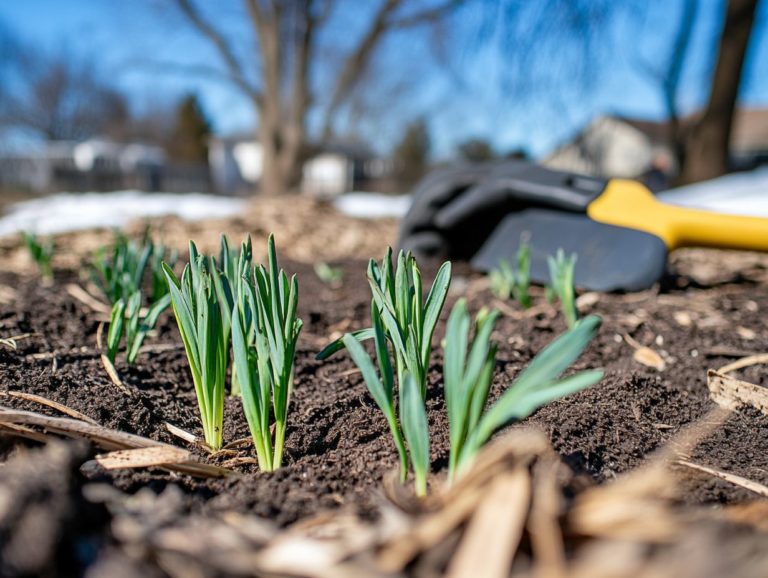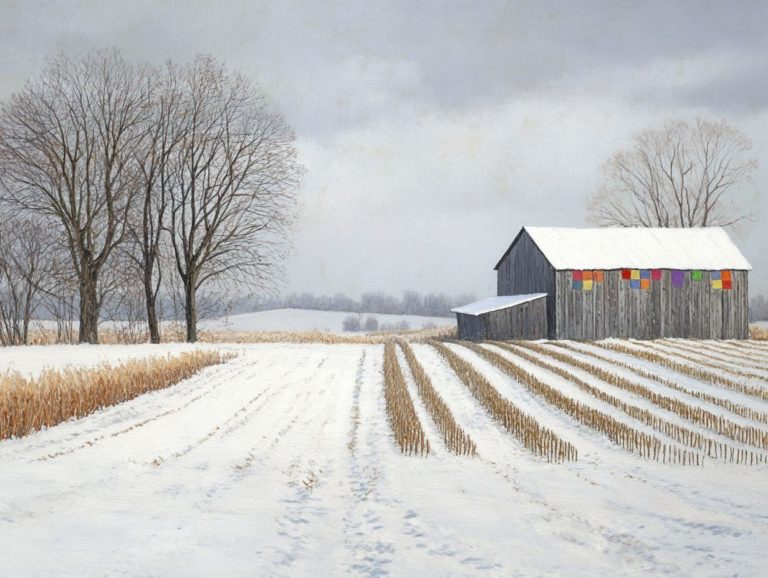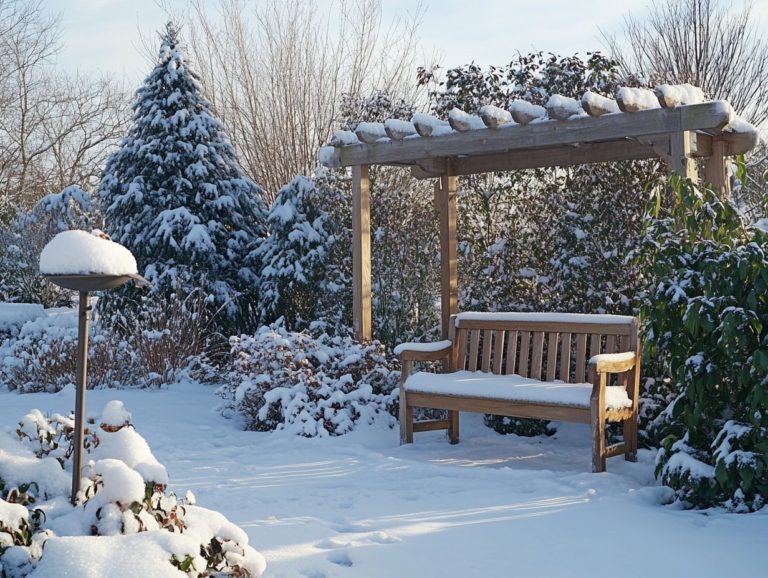Tips for Growing Mushrooms in Winter
Growing mushrooms during the winter months can be an unexpectedly rewarding endeavor. It adds a delicious and nutritious touch to your meals while bringing some cheer to those chilly days. Whether you want to grow mushrooms for culinary use or to explore gourmet varieties, the process can be quite enjoyable.
This guide provides everything you need to embark on this journey, starting with selecting the best mushroom varieties that thrive in winter conditions, such as oyster and shiitake mushrooms. You’ll also learn how to prepare your growing space, whether indoors or outdoors.
You’ll uncover essential tools, including mushroom spawn (the material used to grow mushrooms) and mushroom growing kits. The guide offers a detailed step-by-step process from spawning to harvesting and troubleshooting tips for common issues. You will also learn best practices to maximize both yield and quality.
Prepare to be amazed by how simple and rewarding winter mushroom cultivation can be! From mushroom recipes to expert tips, this guide has it all.
Contents
- Key Takeaways:
- Choosing the Right Type of Mushroom
- Preparing Your Growing Space
- Supplies and Materials Needed
- Step-by-Step Guide to Growing Mushrooms in Winter
- Troubleshooting Common Issues
- Tips for Maximizing Yield and Quality
- Frequently Asked Questions
- 1. How can I grow mushrooms in the winter?
- 2. What types of mushrooms can I grow in the winter?
- 3. Can I use store-bought mushrooms to grow my own in the winter?
- 4. Is it necessary to use a grow light when growing mushrooms in the winter?
- 5. How often do I need to water my mushroom growing kit in the winter?
- 6. What is the best temperature for growing mushrooms in the winter?
Key Takeaways:
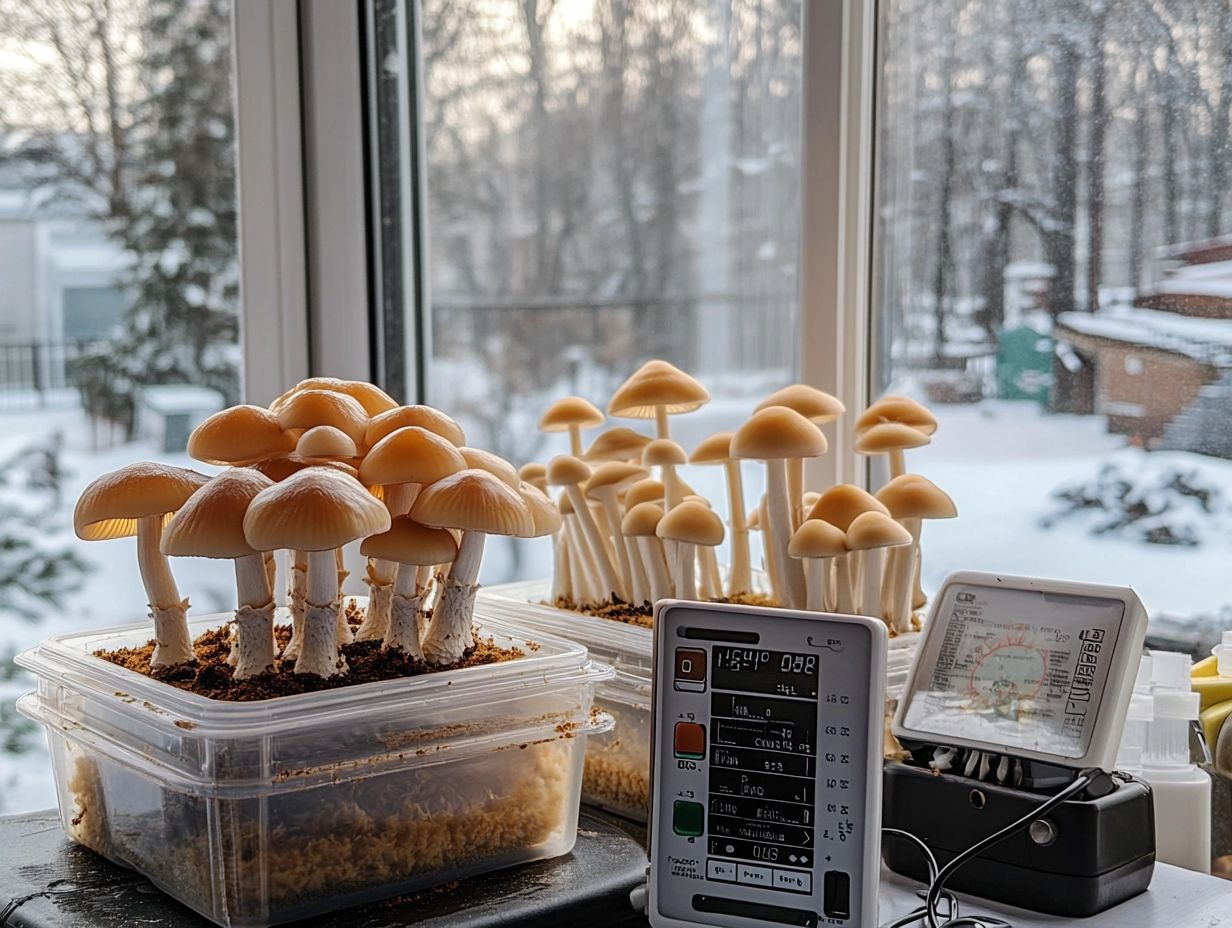
- Choose cold-weather varieties like shiitake or oyster mushrooms for winter success.
- Grow indoors to better control temperature and humidity.
- Maintain proper ventilation and moisture; follow step-by-step instructions for the best results.
Why Grow Mushrooms in Winter?
Growing mushrooms in winter presents a unique opportunity for enthusiasts and cultivators. The cool temperatures and increased humidity during this season create the perfect environment for gourmet varieties such as oyster and shiitake mushrooms. For those interested in maximizing their yield, exploring tips for using greenhouses in winter gardening can be highly beneficial.
With the right indoor techniques or favorable outdoor conditions, you can enjoy a large harvest of fresh mushrooms, ideal for enhancing your culinary creations. This article delves into why winter is an advantageous time for mushroom farming, especially for those aiming to cultivate mushrooms at home or in controlled environments.
You ll discover that certain mushrooms thrive in the colder months, leveraging the seasonal changes that often challenge other crops. Managing moisture levels is essential; too much dryness can hinder growth, while cooler temperatures can keep pests and diseases at bay, which tend to thrive in warmer weather.
By incorporating compost (decomposed organic material) and other nutrient-rich materials, you can foster an optimal growing environment. This allows you to cultivate not only staple varieties but also exotic ones. Understanding how each factor, including mushroom nutrients and temperature control, contributes to successful growth will transform your winter mushroom farming into a fulfilling endeavor.
Choosing the Right Type of Mushroom
Selecting the right type of mushroom is crucial for a successful cultivation experience, as different varieties thrive in distinct conditions. You might consider common choices such as gourmet varieties like oyster mushrooms, shiitake mushrooms, and button mushrooms, each bringing its own unique flavors and culinary possibilities to the table.
Utilizing mushroom spawn, especially through mushroom growing kits, simplifies the journey for both beginners and seasoned cultivators alike. By grasping the characteristics of each type, you empower yourself to make informed decisions as you embark on your mushroom cultivation adventure.
Best Varieties for Winter Growing
The best varieties for winter growing include oyster mushrooms, shiitake mushrooms, and button mushrooms. These types thrive beautifully in cooler temperatures and offer diverse flavors for your mushroom recipes.
These gourmet options not only provide unique tastes but also adapt well to various growing conditions. They are beloved by mushroom lovers, making them ideal for your winter cultivation endeavors.
Whether you’re working with mushroom spawn or kits, knowing which mushrooms to cultivate can significantly elevate your winter farming experience.
For instance, oyster mushrooms flourish at temperatures between 35 F and 65 F and enjoy a humid environment. This humidity can be easily maintained with a misting system.
In contrast, shiitake mushrooms prefer slightly higher temperatures, typically ranging from 45 F to 75 F. They thrive on a substrate rich in lignin, which is a complex organic polymer found in the cell walls of plants, such as hardwood logs or sawdust.
Button mushrooms are the versatile champions, flourishing in temperatures from 55 F to 70 F.
To ensure optimal moisture, maintaining around 80% humidity in the growing area is essential. This allows these mushrooms to fully develop their complex flavors and textures.
Using these smart strategies will set you up for a fantastic winter harvest!
Preparing Your Growing Space
Preparing your growing space is essential for successful mushroom cultivation, whether you choose to grow indoors or outdoors. Consider available space, growing conditions, and the specific type of mushroom you plan to grow.
These factors will directly influence your cultivation area setup. For example, compost beds work wonderfully for certain varieties.
However, hardwood logs may be more suitable for others. By mastering the art of creating the right growing conditions, you’ll establish a solid foundation for a truly bountiful harvest.
Indoor vs. Outdoor Growing
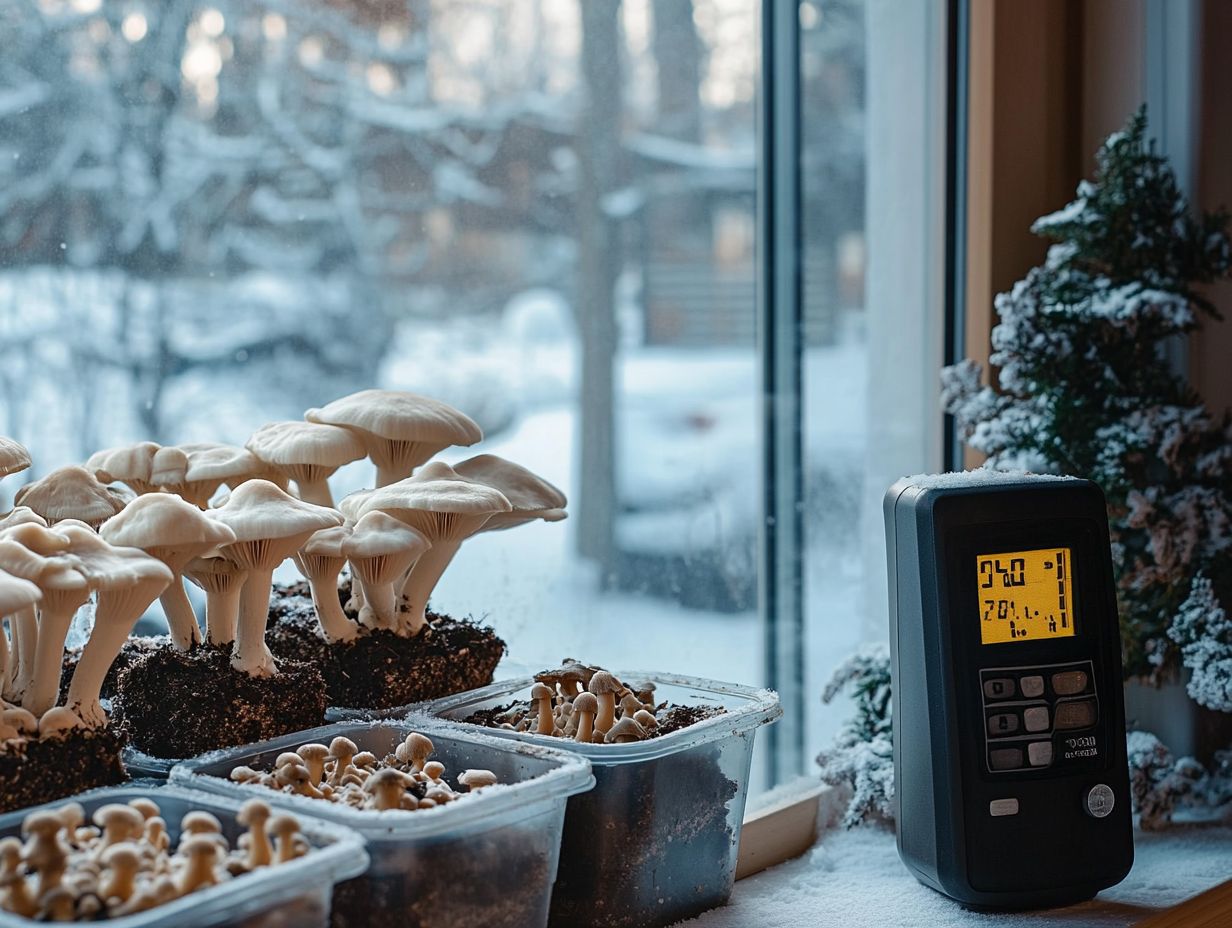
When you’re weighing the choice between indoor and outdoor growing for mushrooms, several critical factors come into play. These include your available space, the local climate, and the specific mushroom varieties you wish to cultivate.
Indoor growing gives you exceptional control over growing conditions like temperature and humidity. This makes it ideal for those delicate gourmet types you might crave.
On the other hand, outdoor growing can be beneficial if you have ample space and access to natural resources. However, it requires a keen understanding of local growing conditions and the natural ecosystem.
When you cultivate mushrooms indoors, you can avoid pests and unpredictable weather. This ensures a reliable yield throughout the year.
Conversely, outdoor cultivation allows you to benefit from the natural ecosystem, often enhancing flavor and growth without artificial inputs. However, you need to be vigilant against pests and fluctuating weather conditions.
Ultimately, your decision between these two methods will depend on your personal circumstances, including available resources, desired levels of control, and your preference for specific mushroom species.
Creating the Ideal Environment
To grow the best environment for mushroom growth, you must diligently monitor key factors such as moisture levels, temperature control, and nutrient availability. The right moisture level is critical, as mushrooms depend on hydration for their growth and development. Proper temperature regulation will ensure that the conditions remain ideal for the specific mushroom varieties you ve chosen, ultimately leading to a bountiful yield.
For example, certain species like shiitake flourish at temperatures between 70 F and 80 F. Oyster mushrooms tend to prefer slightly cooler conditions, around 60 F to 70 F. Maintaining a relative humidity level between 60% and 80% is typically ideal, depending on the variety. Understanding the unique nutrient requirements, such as those found in coffee grounds or straw, for different mushrooms can significantly influence their growth and success.
Experts recommend adding organic materials like coffee grounds or straw to traditional growing substrates. Adding nutrients ensures your mushrooms thrive, leading to a successful mushroom cultivation experience.
Supplies and Materials Needed
Get ready to dive into the world of mushroom cultivation! To successfully grow mushrooms, you must have the right supplies and materials at your disposal. This includes high-quality mushroom growing kits and an array of essential tools and equipment.
These kits typically feature pre-prepared substrates and inoculated spawn, making the process approachable even for beginners. Beyond the kits, investing in specific tools like sterilizers, humidity controllers, and temperature monitors can significantly enhance your cultivation experience, increasing the likelihood of a fruitful harvest.
Essential Tools and Equipment
Essential tools and equipment for mushroom cultivation include humidity controllers, temperature monitors, and sterilizers. These are crucial for maintaining optimal growth conditions to ensure the success of your mushroom projects. Many mushroom growing kits come equipped with a variety of necessary tools to help you get started.
Ready to grow amazing mushrooms? Let s gather the essential tools! To cultivate mushrooms successfully, you should also consider additional items such as:
- Inoculation loops for transferring mycelium (the root-like structure of mushrooms)
- Gloves to maintain a sterile environment
- A good-quality spray bottle to regulate humidity levels
The containers or bags you choose for substrate preparation can profoundly impact the efficiency of your growing process. Each piece of equipment plays a vital role; for instance, maintaining the correct temperature encourages mycelium colonization, while humidity controllers help prevent drying out during various growth stages, ensuring that nutrients are available.
By carefully selecting and utilizing these tools, you can significantly enhance both the yield and quality of your mushroom harvest.
Step-by-Step Guide to Growing Mushrooms in Winter
This essential guide is your ticket to growing mushrooms this winter! It will walk you through each essential phase, from preparing your substrate to harvesting the final product.
Grasping the entire mushroom cultivation process such as sourcing high-quality mushroom spawn and maintaining optimal conditions is vital for achieving a successful yield.
By adhering to these steps, even novice growers can relish the rewards of their efforts in the form of fresh, homegrown mushrooms.
From Spawning to Harvesting
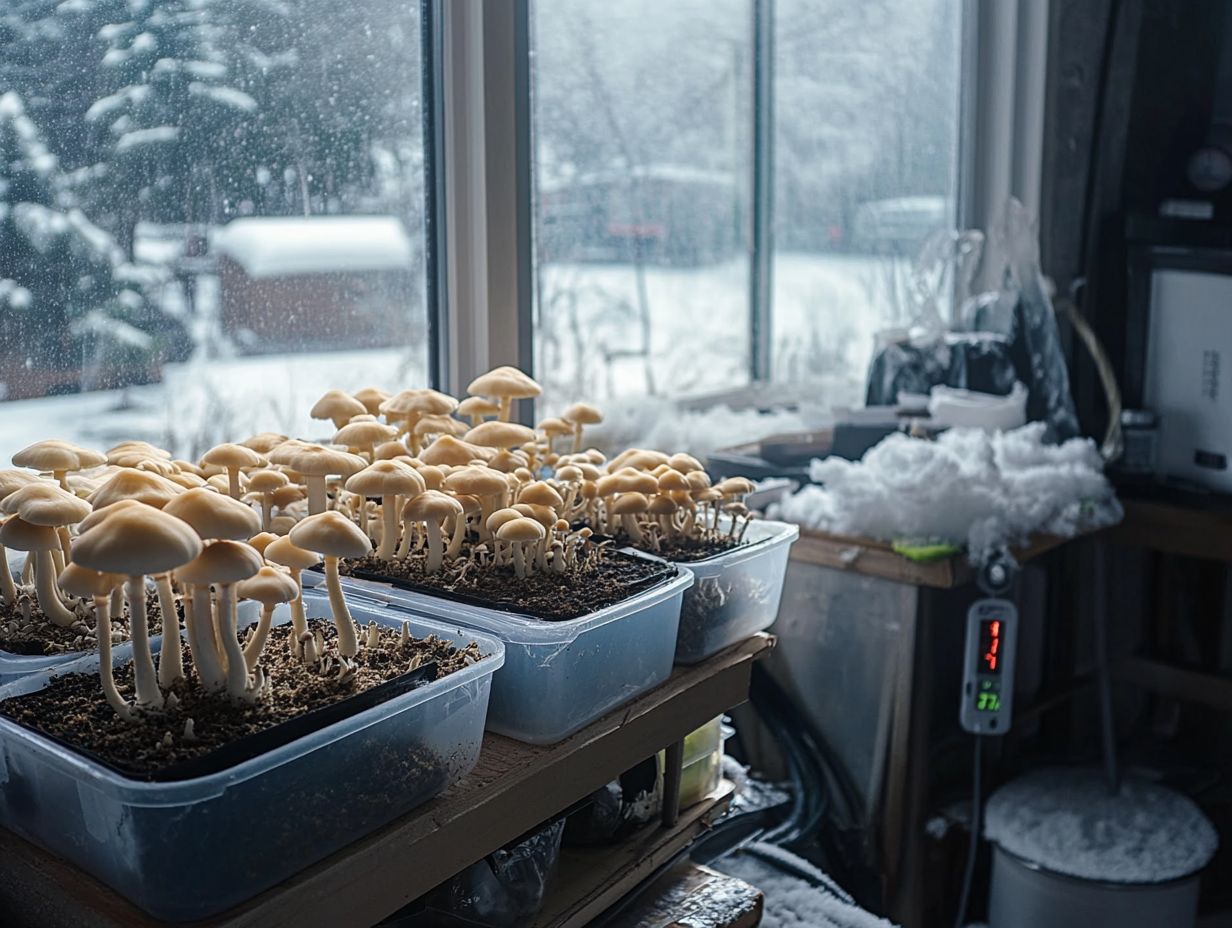
Get ready for an exciting journey! Growing mushrooms from spawn to harvest is a careful yet rewarding adventure. It all begins with high-quality mushroom spawn, and every step requires your keen attention to maintain optimal growth conditions until that moment of harvest arrives. Understanding each phase helps you maximize your yield. You’ll also enjoy the rich flavors of your homegrown mushrooms.
The first critical task is preparing the substrate. The substrate is the material where mushrooms grow, like straw or sawdust. This involves sterilizing materials to eliminate any competing organisms that could hinder your progress.
Once you ve mixed the spawn into the substrate, it s essential to maintain the perfect temperature and humidity levels in the incubation area. These factors greatly influence growth rates, so regular checks for signs of contamination or uneven growth are crucial during this phase.
As the mushrooms start to fruit, you’ll need to adjust light exposure and airflow to promote their healthy development. When the mushrooms reach maturity, employing careful harvesting techniques ensures quality and encourages the cycle of future growth.
Troubleshooting Common Issues
Troubleshooting common issues in mushroom cultivation is crucial for you as a grower. Various challenges can emerge during the process, ranging from pests to environmental fluctuations. Identifying problems quickly can save your mushroom crop from disaster. Understanding the typical issues and their solutions gives you the power to maintain optimal growing conditions, ultimately leading to a successful harvest.
Dealing with Pests and Other Problems
Dealing with pests and challenges in mushroom cultivation demands your utmost vigilance and timely action. Common culprits like flies and mites can disrupt mushroom growth and diminish your yield. It s essential to understand how to identify these pests and employ effective control measures to maintain a thriving mushroom crop.
For example, you might spot aphids as small green or black insects on your mushroom substrate, while webbing can be a telltale sign of spider mites lurking nearby. Adopting integrated pest management strategies is vital; this could involve:
- Introducing beneficial insects that prey on the harmful pests,
- Regularly inspecting your growing environment, and
- Maintaining optimal humidity and temperature levels.
Taking preemptive steps such as using sterile substrates, thoroughly cleaning your growing areas, and ensuring adequate ventilation can significantly reduce the risk of infestations. By cultivating a proactive approach, you can create an ideal environment that minimizes pest-related issues and boosts your overall productivity.
Tips for Maximizing Yield and Quality
Maximizing yield and quality in mushroom cultivation demands your meticulous attention to detail and a commitment to best practices. To achieve a successful harvest, focus on:
- Optimizing growing conditions,
- Maintaining proper moisture levels, and
- Selecting the ideal substrate.
These elements play a crucial role in shaping the taste and texture of your mushrooms, resulting in a high-quality product that enhances a myriad of culinary creations.
Best Practices for Successful Mushroom Growing
Implementing best practices for successful mushroom growing can significantly enhance your yield and quality. This involves ensuring proper ventilation, monitoring temperature and moisture levels, and selecting suitable growing materials tailored to your chosen mushroom varieties.
By following these guidelines, you can maximize your harvest while cultivating mushrooms that are not only flavorful but also packed with nutrition.
Paying close attention to the cleanliness of your growing environment is vital in preventing contamination and disease. These factors can negatively impact your yield and quality. Regularly sterilizing your tools and growing materials safeguards the health of your mushrooms and contributes to a more reliable growth cycle.
Understanding the specific light requirements for each mushroom species can further refine your growth conditions. Crafting an environment that caters to the unique needs of different varieties ensures a thriving harvest that stands out for its exceptional taste and nutritional benefits.
Frequently Asked Questions
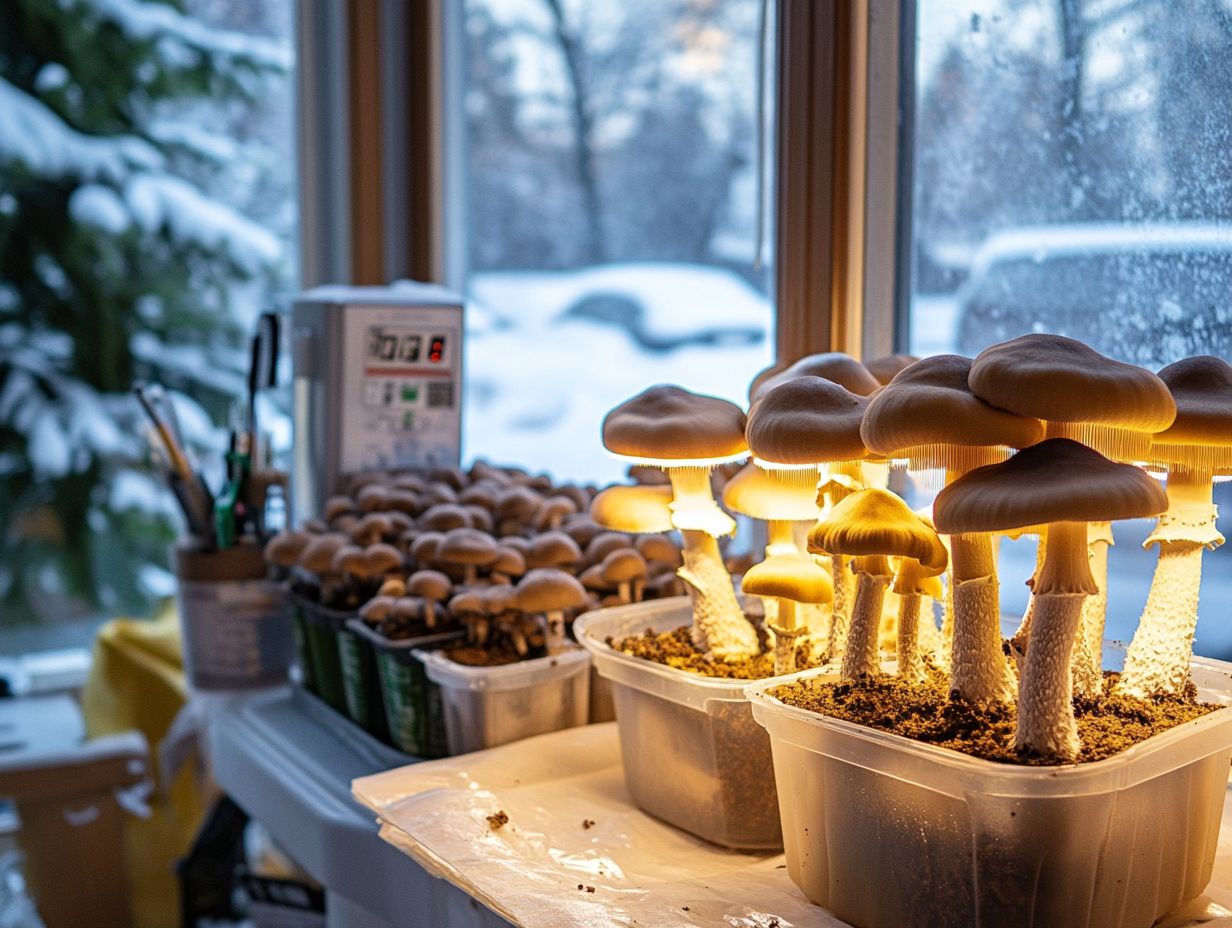
1. How can I grow mushrooms in the winter?
Creating the right environment is the key to growing delicious mushrooms, even in winter! Use a grow tent, provide adequate lighting and humidity, and maintain a consistent temperature. Additionally, consider implementing tips for sustainable winter gardening to enhance your growing success.
2. What types of mushrooms can I grow in the winter?
Many types of mushrooms thrive in winter, including oyster, shiitake, and lion’s mane. Research the best varieties for your climate!
3. Can I use store-bought mushrooms to grow my own in the winter?
While it is possible, it is not recommended. Store-bought mushrooms may contain pesticides that can hinder their growth. It’s best to purchase mushroom spawn or spores from a reputable source.
4. Is it necessary to use a grow light when growing mushrooms in the winter?
Yes! A grow light is essential for mushroom growth. Mushrooms require light for photosynthesis, which is crucial for their development. If you lack a grow light, natural sunlight can work, but its availability may be inconsistent in winter.
5. How often do I need to water my mushroom growing kit in the winter?
The frequency of watering depends on the mushroom type and environmental conditions. Generally, keep mushrooms moist but not waterlogged. Regularly check the moisture level and adjust as needed.
6. What is the best temperature for growing mushrooms in the winter?
The ideal temperature for growing mushrooms in winter is between 60-65 F. Maintaining a consistent temperature is crucial, as fluctuations can affect growth. You may need to invest in a heater or temperature control system for optimal results.
Start your mushroom growing journey today and explore the wonderful world of fungi!

